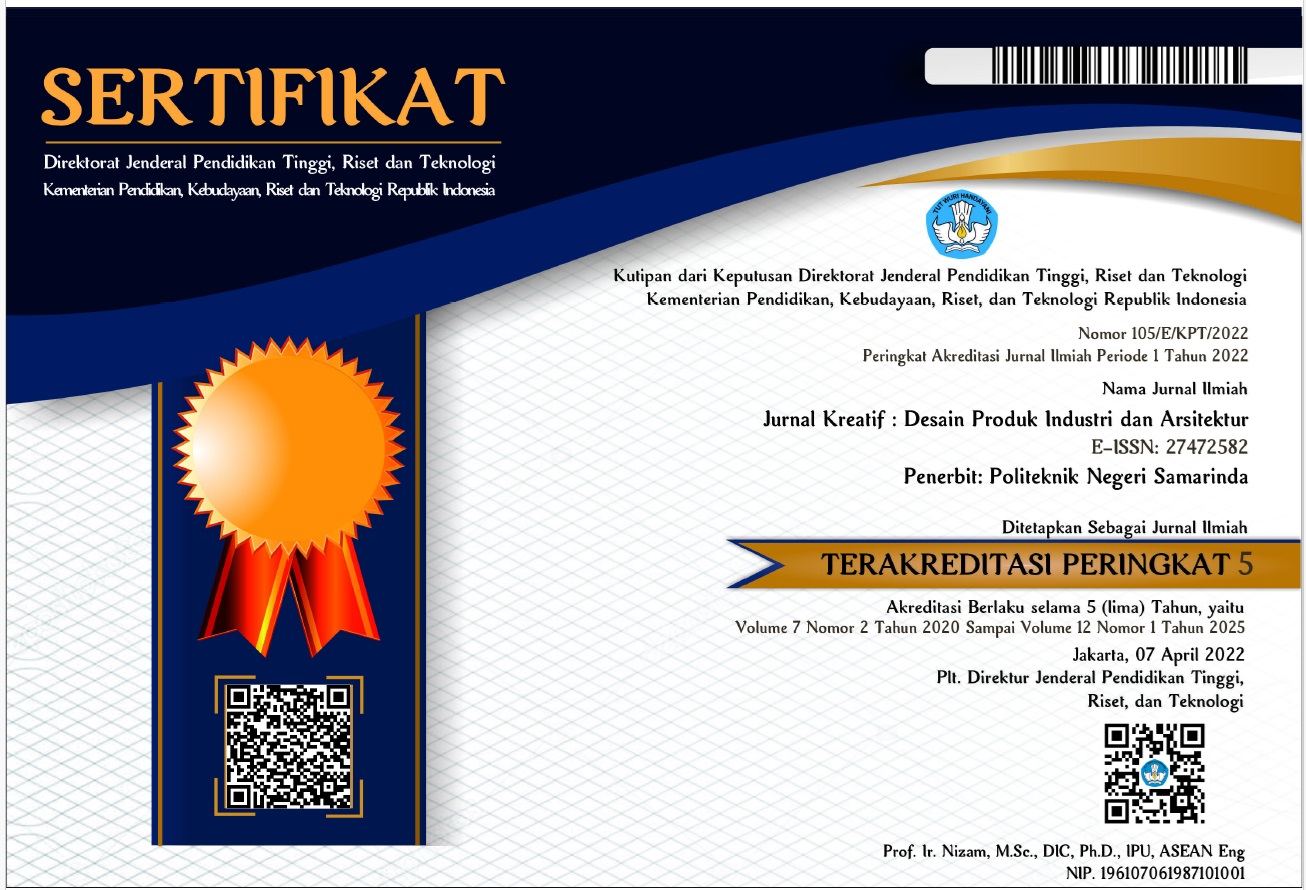DESAIN SARANA BAWA PERALATAN DAN WORKSTATION PEMBERSIH SEPATU SNEAKER
 Abstract views: 555
,
Abstract views: 555
,
 pdf downloads: 321
pdf downloads: 321
Abstract
ABSTRAK
Peralatan atau perkakas pembersih sepatu pada umumnya menggunakan box atau kotak yang menggunakan material kayu maupun plastik kaca sehingga akan memiliki jangka waktu penyimpanan yang tidak cukup panjang. Tetapi, sarana pembawa peralatan pembersih sepatu yang ada saat ini hanya diperuntukan untuk pengguna sepatu berbahan kulit. Sehingga, memiliki keterbatasan untuk pengguna sepatu sneaker yang berbahan kanvas, nylon, suede, dan kulit sintetis. Untuk perawatannya sendiri masih menggunakan metode dry cleaning untuk jenis sepatu sneaker berbahan suede. Tetapi belum menerapkan metode pembersihan wet cleaning untuk sepatu sneaker yang berbahan kanvas, nylon, dan kulit sintetis. Oleh karena itu, perancang berencana membuat sarana membawa peralatan pembersih sepatu sneaker yang disertai meja alas pembersih sepatu sneaker dengan metode dry cleaning dan wet cleaning. Dalam laporan ini yang berjudul “Desain Sarana Bawa Peralatan dan Workstation Pembersih Sepatu Sneaker” memberi alternatif baru dalam desain sarana bawa khususnya pembersih sepatu sneaker. Metode perancangan yang dilakukan yaitu melakukan preliminary design, design development dan final design. Sehingga dihasilkan sarana bawa peralatan pembersih sepatu sneaker dengan desain yang lebih ergonomis, dan estetis yang bernuansa minimalis modern yang dilengkapi dengan meja workstation dan penyimpan peralatan pembersih sepatu sneaker dalam satu desain produk.
Kata Kunci : alat, pembawa, pembersih, sarana, sneaker
ABSTRACT
Shoe cleaning tools or tools generally use boxes or boxes that use wood or plastic glass materials so that they will have a long enough storage period. However, the existing shoe cleaning equipment carriers are only intended for leather shoes users. So, it has limitations for users of sneakers, canvas, nylon, suede and synthetic leather. For his own treatment, it still uses the dry cleaning method for suede shoes. But it has not yet applied the wet cleaning method for sneakers, made from canvas, nylon, and synthetic leather. Therefore, the designer plans to make a sneaker shoe cleaning equipment carrier with a shoe sneaker cleaning table with dry cleaning and wet cleaning methods. In this report entitled "Design of Facilities to Bring Equipment and Sneaker Shoe Cleaning Workstations" provides a new alternative in the design of the means to carry it, especially cleaning sneakers. The design method that is carried out is conducting preliminary design, design development and final design. So that a means to carry sneaker shoe cleaning equipment with a more ergonomic, aesthetic design with modern minimalist nuances is equipped with a workstation table and sneaker shoe cleaning equipment storage in one product design.
Keywords: tool, carrier, cleaner, means, sneaker
Downloads
References
Fashionary. (2015). Shoe Design a Handbook for Footwear Designers.
Suharbianto. (2018). Desain Sarana Bawa Alat Perkebunan. Tugas Akhir. Politeknik Negeri Samarinda. Samarinda. Indonesia.
Alfari. (2017). Mengenal Triplek atau Kayu Lapis. https://www.arsitag.com/article/mengenal-triplek-atau-kayu-lapis. Diakses pada 6 Maret 2019.
Kania. (2018). Beda Jenis Engsel Pintu, Beda Fungsinya: Ini yang Harus Kamu Tahu. https://www.dekoruma.com/artikel/70588/jenis-engsel-pintu. Diakses pada 6 Maret 2019.
Luqman, Hilmy. (2014). Sejarah Sneakers dan Perkembangannya di Indonesia. http://hilmyluqmanap.blogspot.com/2014/05/sejarah-sneakers-dan perkembangannya-di.html. Diakses pada 6 Maret 2019.
Authors who publish with this journal agree to the following terms:
- Copyright on any article is retained by the author(s).
- The author grants the journal, right of first publication with the work simultaneously licensed under a Creative Commons Attribution License that allows others to share the work with an acknowledgment of the work’s authorship and initial publication in this journal.
- Authors are able to enter into separate, additional contractual arrangements for the non-exclusive distribution of the journal’s published version of the work (e.g., post it to an institutional repository or publish it in a book), with an acknowledgment of its initial publication in this journal.
- Authors are permitted and encouraged to post their work online (e.g., in institutional repositories or on their website) prior to and during the submission process, as it can lead to productive exchanges, as well as earlier and greater citation of published work.
- The article and any associated published material is distributed under the Creative Commons Attribution-ShareAlike 4.0 International License













